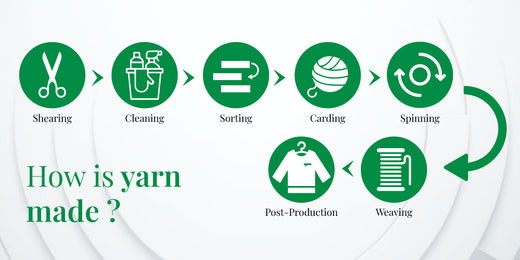
How is Yarn Made?
As with the curiosity of the human mind, it is only sane to question everything that we come across. Today, let’s talk about wool and how it's made.
The first thing you think of when you think wool is probably the cold winters, chilly evenings and chai. Wool is directly associated with winters and good memories. It is perhaps the most comforting thing that man has ever discovered.
Wool has a history of its own. Throughout history, wool meant a lot of different things to a lot of different people. It has been discovered and made a certain way and the process of converting the fur of animals to wearable garments or even yarn has evolved throughout the years.
How Wool Fabric is Made
When we refer to ‘making wool’, we are referring to the process of converting animal fur (fleece) into wool fabric. Usually, the process of making wool includes a lengthy process of shearing, sorting, cleaning, scouring and sometimes even carbonising, carding, spinning, weaving and finishing. Phew! Seems like a lengthy process, doesn’t it?
Manufacturing of wool is usually a lengthy process and involves skill and experience at several stages. This is due to the fact that wool is universal. Although extracted mainly from sheep, wool is also obtained from goats, camels, ox, cashmere, pashmina, llamas and other sources. Each animal has a selection process of its own.
Step 1 - After the selection of wool, the process of ‘making’ wool begins. The chosen animals are sheared using special shearing equipment followed by sorting which includes selection and grading of fleece. Based on the length and diameter of the fibre, wool may be sorted into criteria. Lower quality wool is used for making carpets, upholstery and other items while softer, higher quality yarn is chosen for manufacturing garments.
Step 2 - The chosen wool is neatly organised in criteria of its own. Wool that has been degraded is rejected. Then, the wool is rigorously scoured and cleaned to get rid of bacteria, fungus and other contaminants. To ensure that wool is completely sanitised, it is passed through various baths containing alkaline, soda ash, detergent and other chemicals. It is then rinsed and dried carefully to retain quality.
Step 3 - Sometimes wool is also ‘carbonised’. It involves the process of immersing wool in a solution of sulphuric or equivalent acid to remove any impurities.
Step 4 - The wool is then combed gently to open up the locks and clear out any waves or frizz. This process also straightens the wool which makes the next process of spinning a breeze (no pun intended). Combing is also known as ‘carding’ and this process is usually when other fibres can be introduced into the wool to create a blended fabric.
Step 5 - Spinning is the process where animal fur finally starts transforming into a usable commodity. Wool fibres are spun together to create wool yarn. The spun wool is then sold at commercial outlets in the form of balls, skeins, rollers, etc.
Step 6 - Wool after being spun is finally dyed into the colours that you normally like to choose your wool in. Although many prefer to buy wool in classic colours of brown, tan, grey or beige, it may be dyed into other colours to suit the fashion demands of today. Fun fact: white coloured wool is actually bleached wool that has been stripped of its colour.
Step 7 - The final step which excites all us knitters is the final process of turning wool yarn into beautiful fabrics. Through knitting, crocheting, felting or weaving, wool can be turned into fabric that can be utilised.
Conclusion
The process of making wool is a complicated process that involves multiple processes. The production of wool today follows refined and much evolved techniques that make wool a sought after fabric all around the world. Till today, it remains one of the most sold commodities in the fashion world.
For the highest quality wool yarn, visit India’s largest online knitting store: https://vardhmanknitworld.com/

